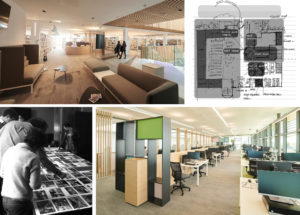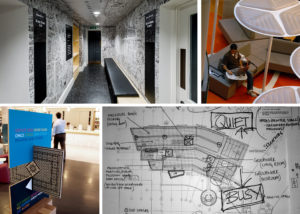People-centred design and libraries
Category: Blog
The following is a guest blog from Scott Mason of Nomad Research Design & Communication Ltd (Nomad RDC), a creative studio that works with people to create meaningful spaces.
 Nomad Research Design & Communication Ltd (Nomad RDC) specialises in people-centred projects which combine consultation, stakeholder engagement and participatory design with professional interior and communication design. In short, we work with the end-users of space to help them to create the places that they want and need.
Nomad Research Design & Communication Ltd (Nomad RDC) specialises in people-centred projects which combine consultation, stakeholder engagement and participatory design with professional interior and communication design. In short, we work with the end-users of space to help them to create the places that they want and need.
Since our inception 14 years ago, we had worked with over 30 institutions, across the UK and Ireland, almost exclusively within education and most often with libraries – some of us have been working with public libraries since well before Nomad started. Our founding partners worked on the Real Programme for GCC as well as Anniesland and Gorbals library.
Back in 2006, while working on the Saltire Centre Project for Glasgow Caledonian University, we had a hunch that working with people, understanding their vision and unlocking their tacit knowledge could lead to better environments. Places where people would feel a sense of ownership and belonging. Initially, we turned to ethnography and psychology to find suitable participatory design methods, and we experimented with interviews, questionnaires, observational techniques, and so on.
Over a decade, many institutions and thousands of participants later and our methods have evolved almost beyond recognition. However, two things elements constant.
- Every project is different. Every library or institution has a distinct community, identity and culture, and this requires a bespoke participatory approach. Some methods are universal, while others are more discrete. Sometimes the methods are tried and tested, and at other times a project demands a new technique. At the Bedford Library-Royal Holloway University of London, we were faced with a newly designed ground floor that was not working. To understand this better, we created a process of mapping the book journey – from the entrance to reshelving. After tracking some 50+ books, it was evident that this journey was taking an unnecessarily circuitous course. Mapping the book journey helped us to streamline the service space creating a simplified route which was more comfortable for staff to use while also generating100 new student seats.
- Gathering the right type of information is essential. The purpose of any people-centred or participatory design process is to generate data that will result in the kind of detail that you can translate into a concrete outcome. Without careful planning, it can be easy to get lost in workshops or interviews that lead to interesting yet relatively useless data. When working with Kings College London, we devised a series of workshops that led the participants on an exploratory design journey resulting in a Vision Brief rich with descriptions, diagrams, visual information and priorities providing the architects with a detailed starting point.
 The key to each of these elements lies in truly understanding the nature of your project and planning it meticulously. Ask yourself – what do we think a library is now? What do we need to find out- what are the big questions? How do we get as many voices involved as possible? Once you answer these questions, the methods that you need to use to explore your project should begin to reveal themselves.
The key to each of these elements lies in truly understanding the nature of your project and planning it meticulously. Ask yourself – what do we think a library is now? What do we need to find out- what are the big questions? How do we get as many voices involved as possible? Once you answer these questions, the methods that you need to use to explore your project should begin to reveal themselves.
We continue to believe that projects constructed from the ideas of everyday people have the potential to be infinitely more inventive and enduring while fostering a sense of well-being and belonging in the most critical stakeholders, the end-user and as we move towards imagining the next generation of libraries we think that this is vital.
Illustration – Montage of projects including The Saltire Centre at Glasgow Caledonian University, The Quadrangle at Kings College London, Bedford Library at Royal Holloway University of London and our latest library project-the Catalyst at Edge Hill University.